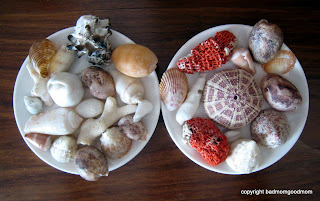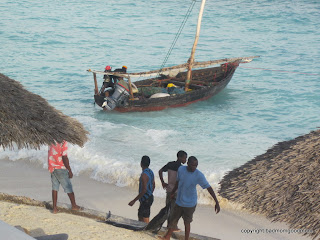One of the many delights of the Mt
Meru Game Lodge and Sanctuary is the "nature walk" that is offered daily at 10 AM and 3 PM. It promises a walk along the
Usa river, which runs right across one edge of the property.

Time is a fluid concept in Tanzania (more on that later). We told the front desk that we were sorry to miss it because we wouldn't be back until 4 PM. No problem, she called the nature guide and he agreed to come at 4 PM to accommodate us. We got back at 4:30 PM, afraid that we had kept him waiting. We went to our rooms to freshen up and he was ready for us at 4:45 PM.
We crossed the highway between Kilimanjaro airport and the major town of
Arusha, about 15 km away from the smaller city of
Usa River, home of the Mt
Meru Game Lodge. We followed a road opposite the lodge gate and through a flower farm.
Arusha, latitude 3 S, grows flowers for the European market, much as Columbia grows flowers for the North American market. It's proximity to Kilimanjaro international airport is no accident.
You can see a square of flowers left unpicked for seed saving in the midfield and Mt
Meru in the background.

This is a very unflattering photo of me, but you can see the bridge over the
Usa river here.

When we crossed the river, we met a flat-bed truck full of women leaving the flower farm at the end of their workday. Mark was unsettled by the sight of the women standing up in the back of the truck and hanging on to the wooden slats on the side. But I pointed out that the truck was not overly crowded, they were smiling, conversing and waved to us; and they didn't have to walk home after a long day at work.
Then we walked along a road with many people walking home from work or school; the kids were in school uniforms. Other people were engaging in commerce along the side of the road. I saw sellers of fruit, sugar cane, BBQ corn, household goods and toys. It's not polite to take pictures of people in Tanzania without their permission so you will just have to imagine the scene.
We also passed many large fields like this. This one has a fruit tree, termite mounds and coffee trees. Notice the trash. There doesn't appear to be any garbage collection. Not much goes to waste here, but there is the ubiquitous plastic, as seen here. The organic matter gets eaten by one of the many goats and cows that roam about.

Here are some coffee berries.

Each home has a large backyard where people grow some vegetables (squash, eggplant, Tanzania spinach, melons, peppers, tomatoes, bitter tomatoes, maize, lettuce..). You can also see banana trees, date trees, papaya and mango trees, sugar cane and coffee here. Notice the number of satellite dishes.
This lady looked at me and my camera and then went back to work. I watched her for some time. She was watering the plants with a large bucket and a big cup. There is no running water here. She hauled the water from the river. After that, she brushed the plants. I think it was an insect control measure, but I am not sure.

We continued to walk until we entered the dense part of the city. We saw this hen and chicks right next to the mill house. Later, we saw a woman selling eggs. Even though it wasn't one of the two main market days for the city, there were still a few women selling produce.

The chef at the Mt Meru Game Lodge proudly serves locally-grown food that he buys on market day. We were introduced to bitter tomatoes on our walk; we ate them for dinner (they were delish).
The scrawny cows that forage around town? They produce exceptionally high butterfat milk that were made into butter and amazing vanilla ice cream. Vanilla beans are a major TZ export crop. Goat cheese and yogurt were also served in many places.
There was also a public restroom and wash house; men on one side, women on the other. We saw kids playing and behaving like kids everywhere.
I was fascinated when I came across the town tailor shop. There was a man sewing at a treadle sewing machine, a woman cutting out a shirt, and another woman ironing with the kind of iron that you heat up on a stove. Because there was no electricity, they were working outside on the veranda.
Have you ever seen a treadle-powered
serger? Me neither.

They exist.

My grandmother had a treadle-powered sewing machine, so this wasn't as fascinating. But look at the display of bright fabrics behind the machine! People come to the tailor, pick a fabric and get a garment made to measure.

I asked if I could buy some fabric and, after the initial shock, they said yes. Mark and I both gravitated to this piece. We asked the price, and were told 6000 Tanzanian shillings, about $4 for the entire 4 yard piece. We took it.

The fabric was really stiff, but softened up when I washed it. The hand felt like polyester and a flame test confirmed it. The women all over Tanzania wear brightly colored fabrics wrapped into a skirt. There are no clothes dryers so laundry was hung up outside in the tropical sun. I was wondering how the colors stayed so bright. Dyed polyester is more colorfast than dyed cotton. I was surprised, when we traveled in Masai regions, to discover that the Masai wear polyester and acrylic plaid fabrics. Synthetics really make sense for the constraints under which they live.
Here's the rest of my fabric haul. I bought the remainder at tourist stores and they are all cotton. The peacock print shows evidence of sun-fading at one end. I am not surprised. It was displayed at the shop entrance. Did I mention we were at -3 degrees latitude? ;-)

The peacock and poly print have been hemmed into tablecloths for our ginormous dinner table. We read while we eat. Iris does her homework on the dining room table. I have a bad habit of inviting people to dinner on the spur of the moment. we need a very long table. 4-yard lengths just about cover the table with a moderate overhang.
(The default unit for the Tanzanian cotton prints is 4 yards. Sometimes, it will be cut into two 2-yard lengths--perfect to wrap around svelte Tanzania women but too short for my hips. Most places charge $9-10 for 4 yards or $5 for one 2-yard length of cotton. Initial offering prices are much higher, but everyone settled for the same prices for the tourist cotton. The canvas and the sheet-width sateen were $6/meter.)
Iris and I plan to make pillows out of the black/white cotton canvas reverse prints. The white sateen made from long-staple Tanzania cotton will be turned into mommy and me white blouses. Mark will be getting a shirt out of the navy/maroon/beige print. The fuchsia floral print is so beautiful; I am content just to pet it for now.
We arrived in Tanzania early one morning and slept until dinner. The next day, I went out and bought my first piece of Tanzania fabric. Now that's efficiency!
Related posts:AddendumThe Usa river guide appears to be an independent
entrepreneur who does not work for the hotel. When someone wants to take a walk outside the hotel grounds, the hotel calls him on his cell phone and he accompanies the guests. He works for tips. Because it was our second day in TZ, we didn't know what was appropriate so we gave him $10. US $ are accepted universally and welcomed in TZ for reasons I will explain in my next shopping post.
While this guide knows a lot about plants and their uses, he lacks the academic knowledge of the trained safari guides that have attended Wildlife College, a post-graduate training for safari guides.
 I didn't think it was a productive creative year at the time I was living it. But, when I looked at the spreadsheet, I saw that I had produced more than I realized. In making this photo collage, I also realized that my spreadsheet was incomplete.
I didn't think it was a productive creative year at the time I was living it. But, when I looked at the spreadsheet, I saw that I had produced more than I realized. In making this photo collage, I also realized that my spreadsheet was incomplete. Although the book describes the 1850s through the 1950s, I definitely fit the patterns of production and consumption described in the book. I sew for better fit and quality. I sew to fit unusual body proportions. I purchase ready-made items that are labor intensive or require a higher level of skill or specialized tools that I do not possess. I sew for myself, family and friends and for charity.
Although the book describes the 1850s through the 1950s, I definitely fit the patterns of production and consumption described in the book. I sew for better fit and quality. I sew to fit unusual body proportions. I purchase ready-made items that are labor intensive or require a higher level of skill or specialized tools that I do not possess. I sew for myself, family and friends and for charity.































